WNJ – A railway that never was
By Mats Björkelund
In the early years of the 20th century a railway was planned through the woodlands of central Sweden. Due to financial reasons it was never built but in 1976 a railway club was founded in the town of Skövde in central Sweden and they set up a challenge: to finally build the long forgotten railway, but as a model layout in H0. The railway was built under the name of WNJ, Westergötland-Nerikes Jernvägar.
Theme
The layout represents a piece of remote landscape, a landscape which just happens to have a railway winding through it. Buildings should have a prototype from the surrounding area and rolling stock should be typical for its time and for a railway of this type. The time period is a little bit vague but it was originally set to 1937. August. A Sunday. In the afternoon.
Landscape
The landscape represents a typical view of this part of Sweden with its combination of small communities, fields, lakes and forests. The old transport system with boats on lakes and canals is mixed with the new railway. Some industrial activity has started but the main transports are still with wood and related products.
Streets and roads are positioned in a way typical of small, existing communities that newly have got a railway. Old roads have been adjusted but you can still see evidence of an old medieval road plan.
With a total size of roughly 100 square meters (1100 square feet) it was possible to have long tracks through open and sparsely populated landscape, typical for this part of the country.
Railway
The real railway was planned to be a branch line, starting at Mölltorp station, on the Skövde-Karlsborg mainline, and then stretch north through the forests. The model railway roughly follows the original plans but some places have been invented and some made more important to justify the railway.
There are three larger stations but the rest are just small ones with two or three tracks. The limited number of tracks makes running difficult but more interesting during traffic. There are some tunnels but on most parts it is possible to follow a train through the landscape.
When the layout was built in the 1970ies the common standard was Peco code 100. We would have built differently today but it is not an easy task to swap a couple of hundred meters of track.
Originally the layout was run with analogue control with a lot of wiring but today it is of course run with digital control. An intercom system makes it possible to run traffic according to specified time plan with correct signaling.
Rolling stock
Especially in the early years there were little ready-to-run to buy in the shops. Most things had to be built from scratch, from etched kits or by major rebuild of commercially available material. Through etched kits produced by club members goods and passenger wagons were added in fairly large numbers. For a club layout the standard was extremely high.
A major set-back was a theft in 2007 when the club lost a major part of the rolling stock (and two buildings). Today we are back to equal or higher numbers of locomotives and wagons but now more things are based on commercially available things. To lose a scratch built item is a traumatic event but you do not want a repeat. The visible difference is small and to be honest, commercial locos are more durable, which is a necessity when running extensively on these long tracks.
Buildings
All buildings, with few exceptions, have a prototype in real life and from the depicted area. Contrary to many other clubs there were members that were not only skilled house builders but actually preferred it. All prototype buildings have been thoroughly measured and documented and the models are built and painted to what is believed to be the conditions during the 1930ies.
Krister Brandt
Many people have contributed to the work through the years but an important member of the club was the late Krister Brandt. When work started in the 1970ies the common depiction of a layout was with photo shots from high level, poor depth of field and bad lighting. Krister Brandt was never fond of this and wanted to create an image of a real railway. He started taking pictures that was often hard to distinguish from real photos. The layout was presented in a series of articles in Sweden’s national hobby magazine, Allt om Hobby. Photos were not only highly believable but also complemented with anecdotes regarding people and events on and around the railway. A story emerged which eventually ended in the book on WNJ, a book with 160 pages, from the Vikings and through the centuries. And never using the words “model railway”…
Many people have through the years confirmed that they have read (and laughed at) Krister’s articles. This way of presenting a layout was a real eye-opener for many. A completely different way of looking at model trains. Not as toy trains for small children but something respectful made by distinguished, middle aged gentlemen (and an occasional female).
More on WNJ
Krister wrote a lot of articles and books presenting the layout but his last effort was to create the documentation used to build the web site www.wnj.se. Unfortunately only available in Swedish.
A regular event occurs around mid June every year, the “Bankalas”. This is good time for visiting the club, look at the layout and discuss this and that with fellow modelers. For visits at other times please contact webmaster@wnj.se.
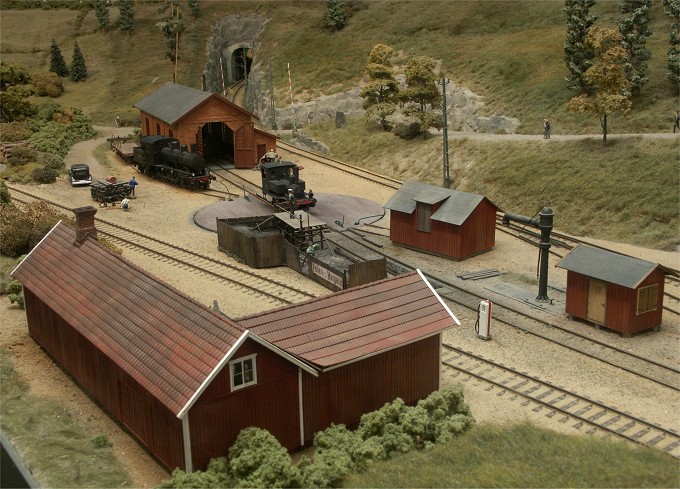
A classic view of the locomotive shed and service area of Mölltorp, well known to people reading Swedish hobby magazines in the late 1970ies. Due to various technical and ground problems the turntable was not finalized until very recently.
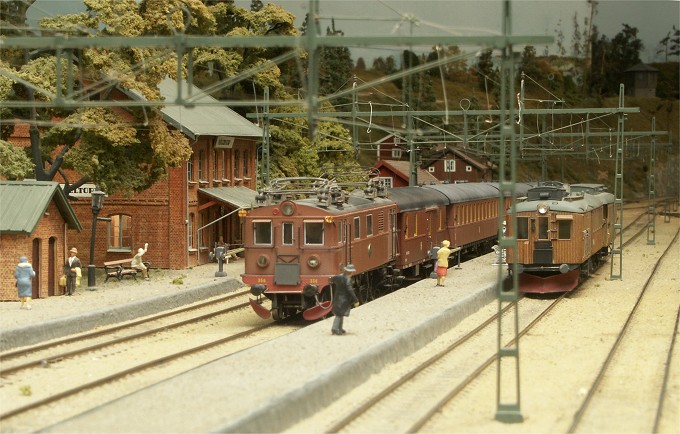
Mölltorp station is the starting point for WNJ, positioned along the electrified national mainline. At the station we see on the track near the station a newly arrived electric passenger train. On the next track we can see one of WNJ’s motor wagons ready for departure. This was actually one that worked well in an otherwise long line of expensive failures.
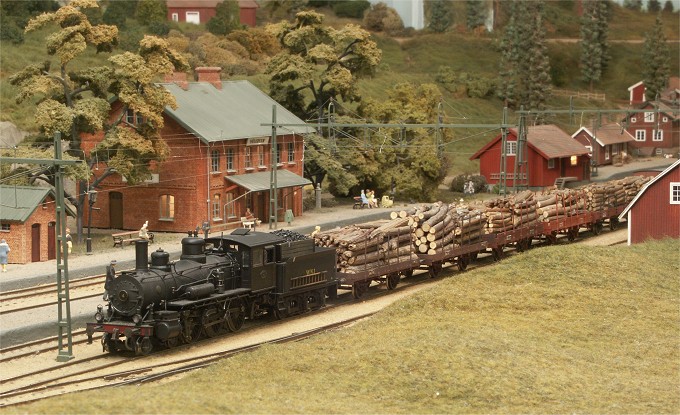
A long timber train is passing Mölltorp, the mainline junction station. In front of the train is locomotive number 4, a locomotive with a long history on the railway. The origin of the locomotive is not fully clarified. Some say it came from America. For all we know it did good work all of its days.
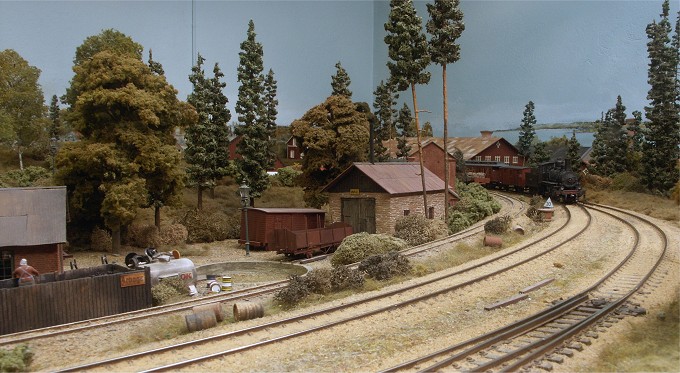
A train arrives to Forsvik station, one of the three main stations along the line. To the left there is a small locomotive shed and a pit for a long gone turntable. These are remains from the old narrow gauge railway that was shut down during the 1920ies.
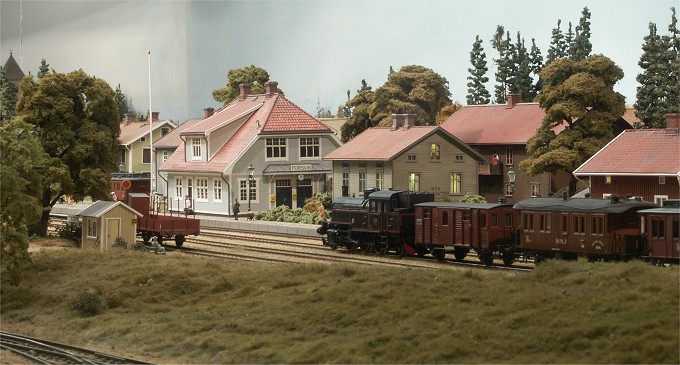
Forsvik is one of the major stations along the line, a transport junction between the railway and “Göta kanal”, the big canal that crosses Sweden from the Atlantic to the Baltic Sea. A large metal industry is situated here which was one of the major customers to WNJ.
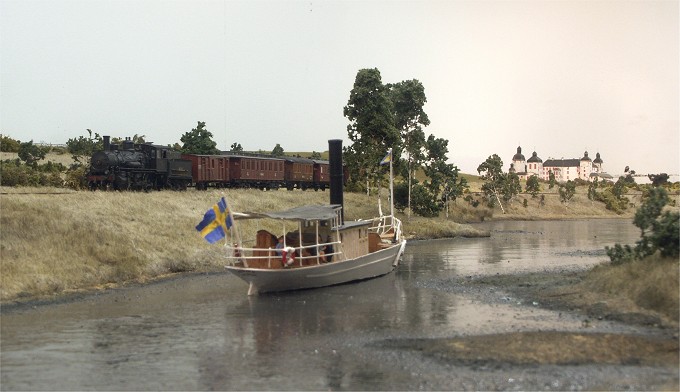
A beautiful view with train and boat and in the far the castle of Läckö. This is an example of a rather extreme form of forced perspective. The castle is actually in 1:400 scale…
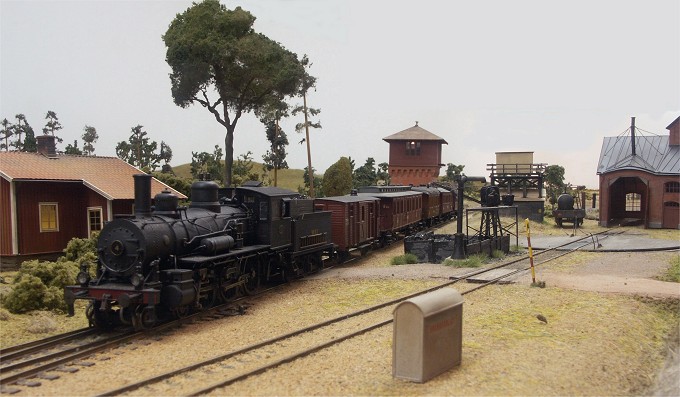
A passenger train arrives to Kvarstad station and passes the locomotive shed. This area was by locals considered an ill reputed area, occupied by railway people with disputable reputation. Good people lived on the right side of the tracks. This was simply “the other side”. No further explanations necessary.
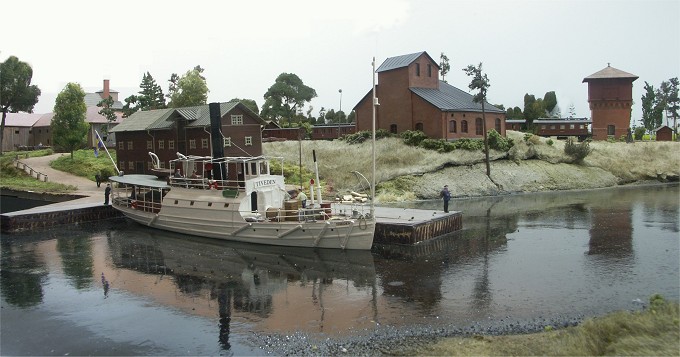
WNJ had some “cooperation” with the boat traffic on the surrounding lakes and along “Göta Kanal”. The “cooperation” mainly comprised endless discussions on tariffs and split of traffic and neither part gained much from it. Increasing costs and less traffic eventually led to the demise of both companies in the 1950ies. Only minor traces can be found in the landscape today.
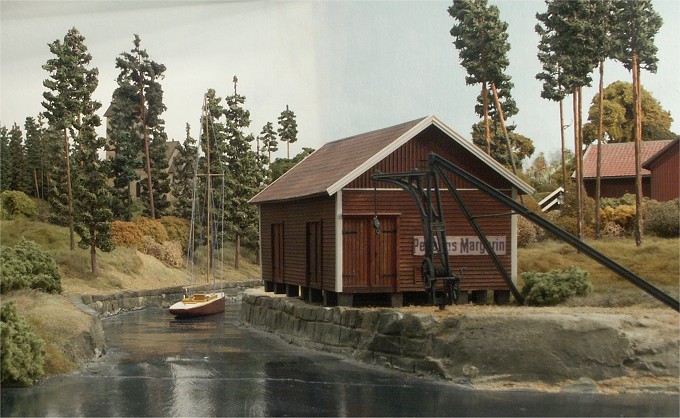
The entrance to “Göta kanal” in Forsvik. This big canal crosses Sweden from the North Sea to the Baltic Sea and was partly built by Russian prisoners of war in the first half of the 19th century. The crane to the right is built from original drawings we found at in the local library of Forsvik. It is mainly built using code70 rails with some custom etched parts.
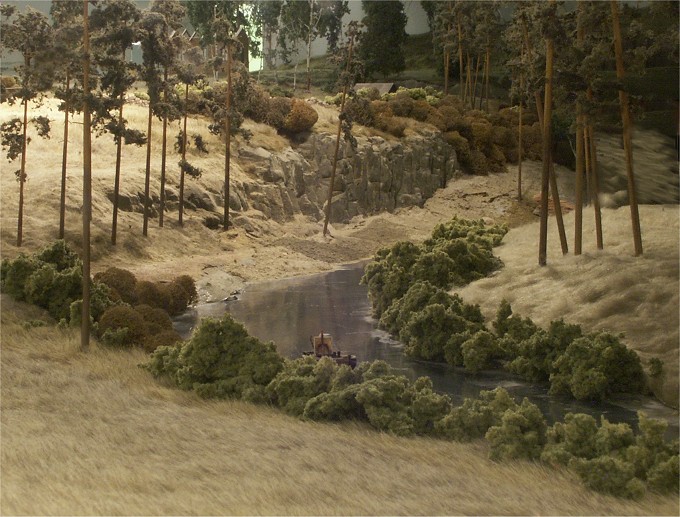
This tranquil small stream, running through the woods, was a popular place for the locally well known painter, A Chrylberg, which can be seen in the boat at the centre of the picture. This piece of landscape is somewhat of a conundrum because it can hardly be seen from any normal view point. This picture was taken recently, after removing a service hatch in the middle of the landscape. Probably less than ten people have ever seen it. The layout still presents its mysteries.
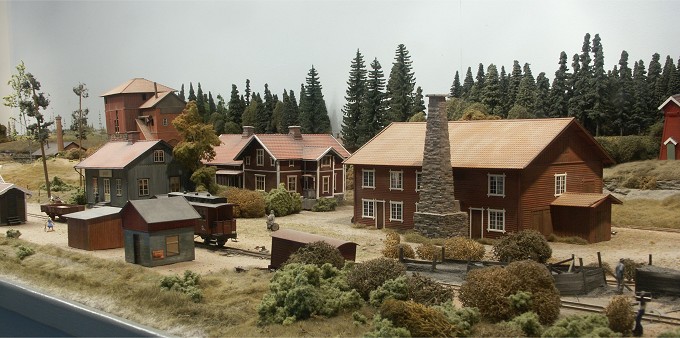
This is “Upsiöö bruk”, an industrial site in the middle of the forest with its iron furnace and surrounding iron manufacturing buildings. The industry was badly mishandled through centuries and no modern iron process was ever used. Lancashire or Bessemer was considered outlandish and not to be trusted. The production was minimal and was stopped shortly after this picture was taken. A nearby lime stone quarry was in use up until the late 40ies.
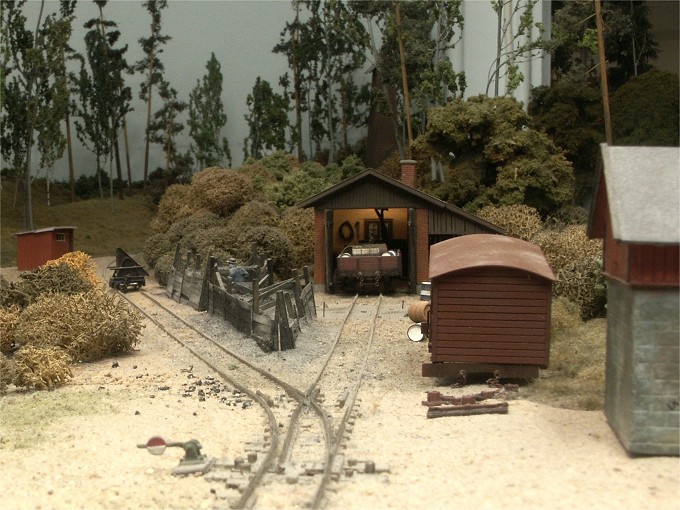
Before the standard gauge railway was built there was already a small narrow gauge railway here. Through a merger they become one railway company (even in the railway name, which actually is plural) but, as usual, most of the narrow gauge railway was closed down shortly after. A small part was kept for local transports around the iron furnace of “Upsiöö bruk”. Here we can see the small locomotive shed that was kept for storage and simple repairs.
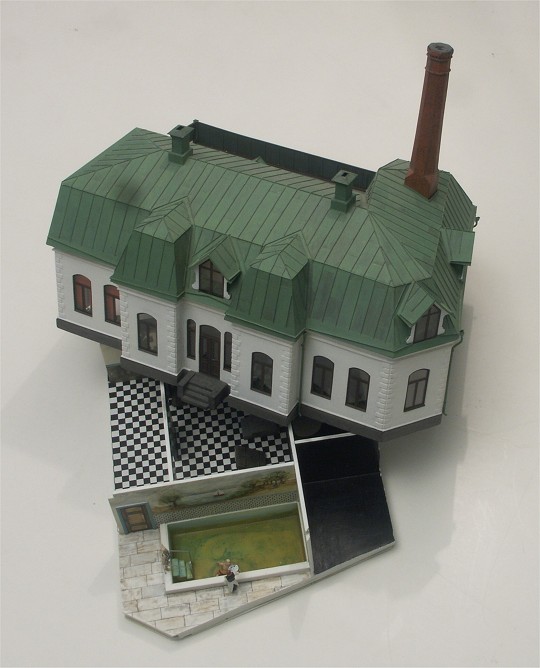
This is an example of the quality of the buildings on the layout. This is a model of the bath house of Falköping, still existing in real life if you want to check for errors. Note the interior wall painting. The natural question is of course: Why bother making an interior that no one will ever see. Answer? You sleep better at night if you know it is right…